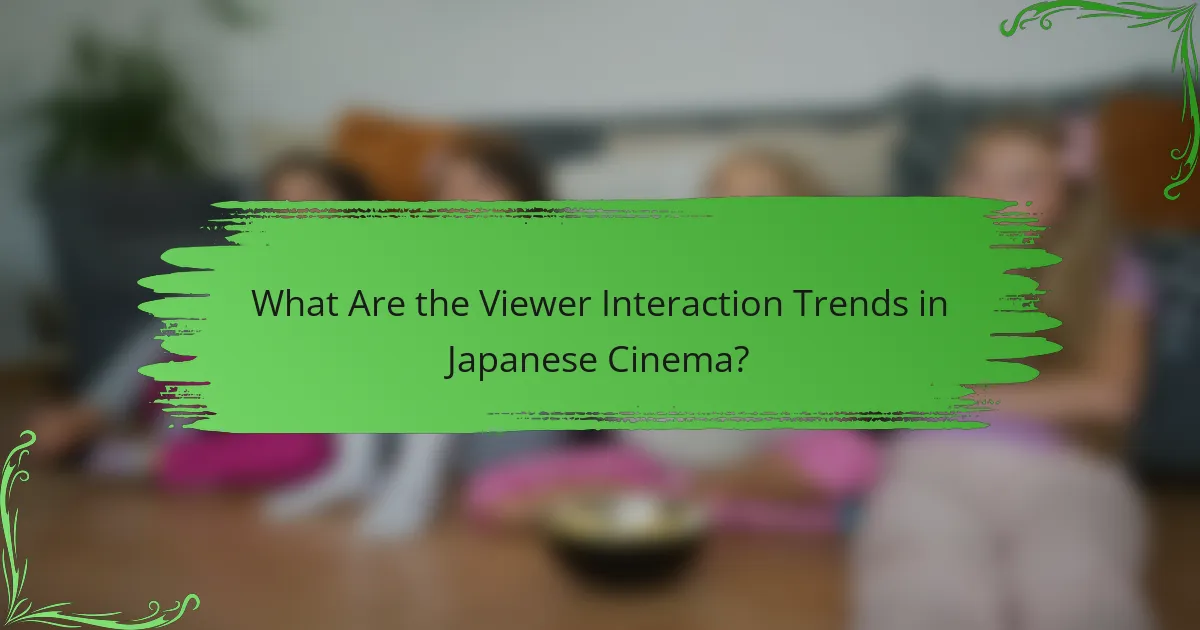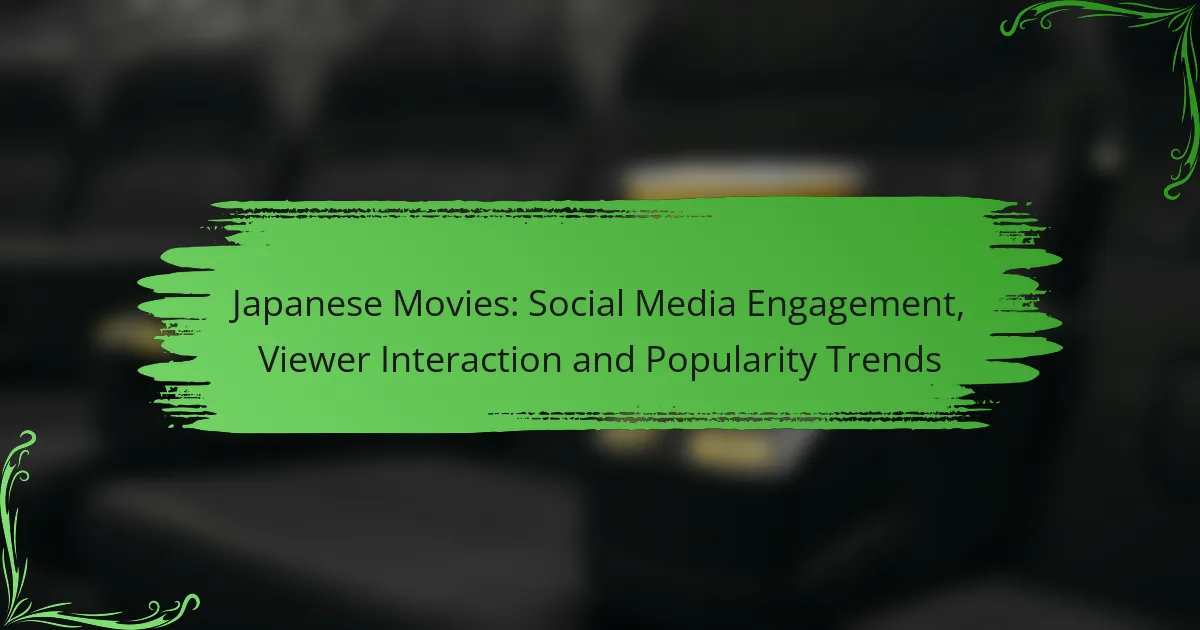Japanese movies are leveraging social media to foster audience engagement through strategic content sharing and interactive campaigns. By utilizing platforms like Twitter, Instagram, and TikTok, filmmakers create a dynamic environment that encourages viewer interaction and community discussions, ultimately enhancing the overall cinematic experience. As a result, films that resonate with current trends and cultural phenomena often gain significant popularity and buzz online.

How Do Japanese Movies Engage Audiences on Social Media?
Japanese movies actively engage audiences on social media through strategic content sharing, interactive campaigns, and influencer partnerships. These methods create a dynamic environment where viewers can connect with films and each other, enhancing overall interest and participation.
High engagement on platforms like Twitter
Twitter serves as a primary platform for Japanese movie promotion, where hashtags and trending topics can significantly boost visibility. Fans often participate in discussions, share their thoughts, and post reviews, creating a lively dialogue around new releases.
Additionally, film studios frequently host live-tweeting events during movie premieres, allowing audiences to engage in real-time. This interaction can lead to increased excitement and anticipation, driving more viewers to theaters.
Influencer collaborations boost visibility
Collaborating with influencers is a key strategy for Japanese movies to reach wider audiences. Influencers with large followings can create buzz by sharing trailers, behind-the-scenes content, or personal reviews, effectively leveraging their credibility to attract viewers.
These partnerships often include exclusive content or giveaways, which incentivize followers to engage with the movie’s social media channels. This approach not only enhances visibility but also fosters a sense of community among fans.
Interactive content drives viewer participation
Interactive content, such as polls, quizzes, and fan art contests, encourages viewer participation and strengthens community ties. Japanese movies often utilize these formats to gather audience opinions or preferences, making fans feel valued and involved in the filmmaking process.
For instance, a movie may host a poll asking fans to vote on their favorite character or scene, which can then be shared widely, further promoting the film. This two-way interaction not only boosts engagement but also creates a more invested audience base.

What Are the Viewer Interaction Trends in Japanese Cinema?
Viewer interaction trends in Japanese cinema are increasingly focused on engaging audiences through digital platforms. This includes utilizing social media for direct communication, fostering community discussions, and enhancing viewer experiences during and after film releases.
Increased use of polls and Q&A sessions
Japanese filmmakers and studios are leveraging social media to conduct polls and Q&A sessions, allowing fans to express their opinions and ask questions directly to creators. This interactive approach not only boosts engagement but also helps filmmakers gauge audience preferences and expectations.
For example, platforms like Twitter and Instagram are commonly used for these activities, where fans can vote on aspects like character development or plot twists. Engaging in this way can significantly enhance viewer loyalty and anticipation for upcoming releases.
Live streaming events enhance viewer connection
Live streaming events, such as virtual premieres and behind-the-scenes tours, are becoming popular in Japanese cinema. These events create a sense of immediacy and connection, allowing fans to participate in real-time discussions and interact with cast and crew members.
Such events often include live chats, where viewers can ask questions and receive instant responses, fostering a community atmosphere. This strategy not only increases excitement around a film but also encourages viewers to share their experiences on social media, amplifying the film’s reach and popularity.

Which Japanese Movies Are Most Popular on Social Media?
Japanese movies that gain traction on social media often reflect current trends, cultural phenomena, and viewer engagement. Films that resonate with audiences typically generate significant buzz across platforms like Twitter, Instagram, and TikTok.
Top trending films in 2023
In 2023, several Japanese films have captured the attention of social media users. Titles such as “Suzume no Tojimari” and “The First Slam Dunk” have not only topped box office charts but also sparked extensive discussions online. These films often feature compelling narratives and stunning visuals that resonate with both domestic and international audiences.
Social media platforms serve as a barometer for popularity, with hashtags and challenges related to these films trending regularly. Engaging content, such as fan art and behind-the-scenes footage, further amplifies their reach, making them staples in online conversations.
Social media buzz around anime adaptations
Anime adaptations of popular manga or light novels frequently generate substantial social media buzz. Fans actively discuss character development, plot twists, and animation quality, creating a vibrant online community. Titles like “Attack on Titan” and “Demon Slayer” have seen explosive growth in engagement, often leading to viral moments and memes.
To capitalize on this trend, filmmakers and studios should actively engage with fans through social media channels. Hosting Q&A sessions, sharing exclusive content, and encouraging user-generated content can enhance viewer interaction and loyalty, ultimately driving ticket sales and streaming views.

What Factors Influence Popularity Trends of Japanese Movies?
The popularity trends of Japanese movies are influenced by various factors, including release timing, critical acclaim, and audience engagement. Understanding these elements can help filmmakers and marketers optimize their strategies for better viewer interaction and success.
Release timing and seasonal trends
Release timing plays a crucial role in the popularity of Japanese movies. Films released during peak seasons, such as summer or year-end holidays, often attract larger audiences due to increased leisure time and holiday promotions.
Additionally, aligning releases with cultural events or festivals can enhance visibility. For instance, films that coincide with the cherry blossom season or New Year celebrations may resonate more with audiences, leading to higher box office returns.
Critical acclaim and awards recognition
Critical acclaim significantly impacts the popularity of Japanese films. Movies that receive positive reviews from reputable critics or win prestigious awards tend to attract more viewers. Recognition at international film festivals can also elevate a film’s status and expand its audience beyond Japan.
For example, films like “Spirited Away” and “Shoplifters” gained international acclaim, which not only boosted their popularity domestically but also helped them achieve significant box office success abroad. Filmmakers should aim for quality storytelling and production to enhance their chances of receiving critical recognition.

How Do Cultural Themes Affect Viewer Engagement?
Cultural themes significantly influence viewer engagement by resonating with audiences’ values and experiences. When films reflect societal issues or explore the balance between tradition and modernity, they foster deeper connections with viewers, enhancing interaction and popularity.
Representation of societal issues
Japanese movies often tackle pressing societal issues such as mental health, family dynamics, and economic challenges. By portraying these themes authentically, filmmakers create relatable narratives that engage viewers on a personal level. For example, films addressing the struggles of youth unemployment resonate with younger audiences facing similar challenges.
Moreover, the representation of societal issues can spark discussions on social media, allowing viewers to share their thoughts and experiences. This interaction not only boosts the film’s visibility but also encourages a community of viewers who feel connected through shared concerns.
Exploration of traditional vs. modern values
The tension between traditional and modern values is a recurring theme in Japanese cinema, often depicted through character conflicts and societal changes. Films that explore this dynamic can attract diverse audiences, as they reflect the ongoing dialogue within Japanese society about preserving cultural heritage while embracing modernity.
For instance, movies that showcase the clash between elder generations adhering to traditional customs and younger generations seeking contemporary lifestyles can engage viewers by prompting them to reflect on their own values. This exploration fosters discussions and enhances viewer interaction, particularly on platforms like Twitter and Instagram, where audiences share their perspectives on these themes.

What Metrics Are Used to Measure Engagement?
Engagement metrics for Japanese movies on social media typically include likes, shares, comments, view counts, and audience retention rates. These metrics provide insights into how well a film resonates with viewers and its overall popularity.
Likes, shares, and comments analysis
Likes, shares, and comments are fundamental indicators of viewer engagement on social media platforms. A high number of likes suggests that the content is well-received, while shares indicate that viewers find it valuable enough to recommend to others. Comments provide qualitative feedback, allowing filmmakers to gauge audience sentiment and preferences.
For instance, a Japanese film trailer that garners thousands of likes and shares within a short period may indicate strong interest, while a high volume of comments can reveal specific viewer reactions or questions. Tracking these metrics over time can help identify trends and inform marketing strategies.
View counts and audience retention rates
View counts measure how many times a film’s content has been watched, serving as a basic metric of popularity. However, audience retention rates are crucial for understanding how engaging the content is; they indicate the percentage of viewers who continue watching until the end. High retention rates suggest that the film maintains viewer interest throughout its duration.
For example, a Japanese movie trailer with a view count in the hundreds of thousands but a retention rate below 50% may indicate that while many are clicking to watch, few are staying engaged. Filmmakers should aim for retention rates above 60% to ensure that their content captivates the audience effectively.

How Do Streaming Platforms Impact Japanese Movie Popularity?
Streaming platforms significantly enhance the popularity of Japanese movies by providing broader access and exposure to diverse audiences. This increased visibility helps films reach viewers who may not have had the opportunity to see them in traditional theaters.
Increased accessibility through platforms like Netflix
Platforms like Netflix have revolutionized how audiences access Japanese films, making them available to a global audience. Viewers can now easily find and watch a wide range of genres, from anime to live-action dramas, without geographical restrictions.
This accessibility leads to higher viewer engagement and interaction, as audiences can share their thoughts and recommendations on social media. The ability to stream movies at any time encourages binge-watching and fosters a community of fans who discuss and promote their favorite titles online.
Moreover, streaming services often invest in original Japanese content, further boosting the visibility of local filmmakers. This trend not only elevates the popularity of existing films but also encourages the production of new and innovative works that can capture the interest of both domestic and international viewers.
